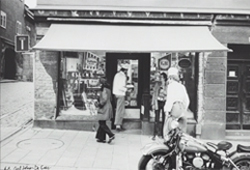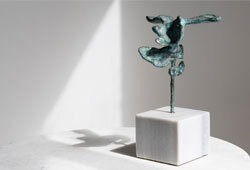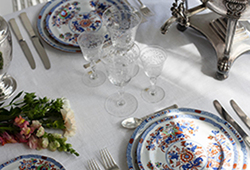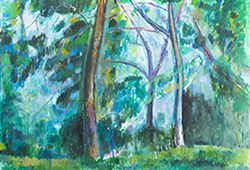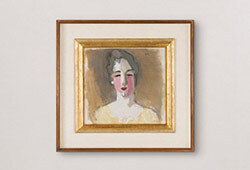Erik Olson
"Månsken"
Signed and dated Erik.O. 1926. Oil on canvas laid on panel, 47.5 x 25.5 cm. Executed in Mayet 1924.
Provenance
Postmaster Yngve Dillberg (1885-1972), Halmstad, acquired directly from the artist.
Thence by descent within the family.
Uppsala Auktionskammare, Important Sale, 19-20 May 2021, lot 425.
Acquired from the above sale by the present owner.
Literature
Christian Faerber (ed.), "Konst i svenska hem II: målningar och skulpturer från 1800 till våra dagar", volume 6, 1942, listed in Postmaster Yngve Dillberg's Collection, Ystad, no. 453, p. 295.
Viveka Bosson, "Halmstad-Berlin-Paris:Målar-resa genom 20-talet": Carlsund, Clausen, GAN, Jonson, Mörner, Lorentzon, A. Olson, E. Olson, Thorén, Österblom around Archipenko, Léger, Ozenfant, 1984, depicted p. 127.
Viveka Bosson, "I Légers ateljé", 1994, depicted.
More information
In February of the year 1924, Erik Olson and his cousin Waldemar Lorentzon could finally travel to Paris for the first time. A journey much anticipated, the two young artists from Halmstad had long dreamed of venturing out into the world and spreading their wings, and finally, they had managed to gather enough travel funds. Erik's brother Axel had traveled to Berlin a couple of years earlier and was deeply impressed by the artistic liberation that inspired there, but perhaps especially by the encounters with GAN, who became something of a father figure to them. In GAN, they found a role model, and he drew them to the French metropolis, which was the city of endless possibilities. Upon arrival, they knocked on GAN's door, who lived in Montparnasse at 86 rue Nôtre-Dame-des-Champs. They were warmly received, and soon GAN arranged for Erik and Waldemar to take over sculptor Källström's two rooms in the house, placing them right in the midst of the epicenter of modern art. In the same building, the couple Grünewald also had their studio, the composer and artist Gösta Nystroem had his residence, but above all, it was here that the master of masters, Fernand Léger, worked. On the ground floor, he had recently opened his painting school, Académie Moderne, where Erik and Walle were welcomed, thus becoming part of Léger's very first circle of students.
At the academy, Léger conducted teaching that was both classical and revolutionary. Léger was inspired by the pulsating rhythm of modern life, by the machine as humanity's liberator, and he taught his students to broaden their vision to see beauty everywhere. Various plastic forms like a chair, a pot, or a machine part were contrasted with a softer human figure, the spaces in between, the intervals, became just as important, as did the sense of interaction between depth and surface, the different elements painted in pure and vivid tube colors merged into a interplay that lived and vibrated with life, like the rhythmically pounding motor of a painterly machine. Erik and Waldemar were diligent students, and soon they both became Léger's favorite pupils, he soon let them prepare and enlarge his own works, which the master then signed himself.
"Moonlight" is signed and dated 1926, which is probably a later date as the painting is listed in the literature as from 1924, executed in Mayet-d'École. "Moonlight" is both playful and elegant. One can clearly see the influences from the teacher Léger and his distinctive tubism, a version of cubism where he emphasized cylindrical forms. The imaginative composition and the ambivalent, dynamic space have elements of so-called "impossible figures". The scene is architecturally confined by the geometric facades of the houses framing the motif with the three figures in the foreground and the man on the stairs. Above them, the moon shines on them like a spotlight on a theater stage, with the stars acting as spotlights in the night sky.
"Moonlight" was acquired directly from the artist by postmaster Yngve Dillberg (1885-1972), who was a close friend of several members of the Halmstad group, especially Erik and Axel Olson and Waldemar Lorentzon. Subsequently, "Moonlight" has been inherited within the family and has never been offered for sale before.
Yngve and Martha Dillberg were close friends with several members of the Halmstad group, especially Erik Olson, Axel Olson, and Waldemar Lorentzon, and served at times as patrons to the artists.






